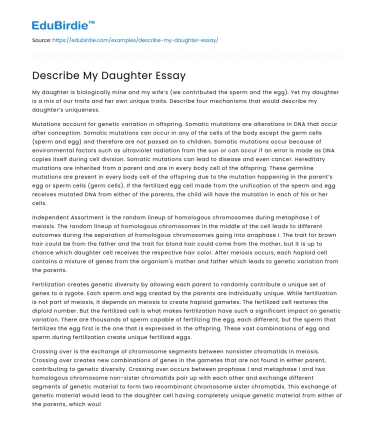My daughter is biologically mine and my wife’s (we contributed the sperm and the egg). Yet my daughter is a mix of our traits and her own unique traits. Describe four mechanisms that would describe my daughter’s uniqueness.
Mutations account for genetic variation in offspring. Somatic mutations are alterations in DNA that occur after conception. Somatic mutations can occur in any of the cells of the body except the germ cells (sperm and egg) and therefore are not passed on to children. Somatic mutations occur because of environmental factors such as ultraviolet radiation from the sun or can occur if an error is made as DNA copies itself during cell division. Somatic mutations can lead to disease and even cancer. Hereditary mutations are inherited from a parent and are in every body cell of the offspring. These germline mutations are present in every body cell of the offspring due to the mutation happening in the parent’s egg or sperm cells (germ cells). If the fertilized egg cell made from the unification of the sperm and egg receives mutated DNA from either of the parents, the child will have the mutation in each of his or her cells.
Save your time!
We can take care of your essay
- Proper editing and formatting
- Free revision, title page, and bibliography
- Flexible prices and money-back guarantee
Independent Assortment is the random lineup of homologous chromosomes during metaphase I of meiosis. The random lineup of homologous chromosomes in the middle of the cell leads to different outcomes during the separation of homologous chromosomes going into anaphase I. The trait for brown hair could be from the father and the trait for blond hair could come from the mother, but it is up to chance which daughter cell receives the respective hair color. After meiosis occurs, each haploid cell contains a mixture of genes from the organism's mother and father which leads to genetic variation from the parents.
Fertilization creates genetic diversity by allowing each parent to randomly contribute a unique set of genes to a zygote. Each sperm and egg created by the parents are individually unique. While fertilization is not part of meiosis, it depends on meiosis to create haploid gametes. The fertilized cell restores the diploid number. But the fertilized cell is what makes fertilization have such a significant impact on genetic variation. There are thousands of sperm capable of fertilizing the egg, each different, but the sperm that fertilizes the egg first is the one that is expressed in the offspring. These vast combinations of egg and sperm during fertilization create unique fertilized eggs.
Crossing over is the exchange of chromosome segments between nonsister chromatids in meiosis. Crossing over creates new combinations of genes in the gametes that are not found in either parent, contributing to genetic diversity. Crossing over occurs between prophase I and metaphase I and two homologous chromosome non-sister chromatids pair up with each other and exchange different segments of genetic material to form two recombinant chromosome sister chromatids. This exchange of genetic material would lead to the daughter cell having completely unique genetic material from either of the parents, which would explain your daughter’s uniqueness.
Did you like this example?
Make sure you submit a unique essay
Our writers will provide you with an essay sample written from scratch: any topic, any deadline, any instructions.
Cite this paper
-
APA
-
MLA
-
Harvard
-
Vancouver
Describe My Daughter Essay.
(2022, September 27). Edubirdie. Retrieved November 21, 2024, from https://edubirdie.com/examples/describe-my-daughter-essay/
“Describe My Daughter Essay.” Edubirdie, 27 Sept. 2022, edubirdie.com/examples/describe-my-daughter-essay/
Describe My Daughter Essay. [online].
Available at: <https://edubirdie.com/examples/describe-my-daughter-essay/> [Accessed 21 Nov. 2024].
Describe My Daughter Essay [Internet]. Edubirdie.
2022 Sept 27 [cited 2024 Nov 21].
Available from: https://edubirdie.com/examples/describe-my-daughter-essay/
copy






 Stuck on your essay?
Stuck on your essay?

